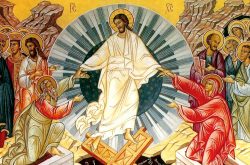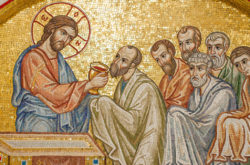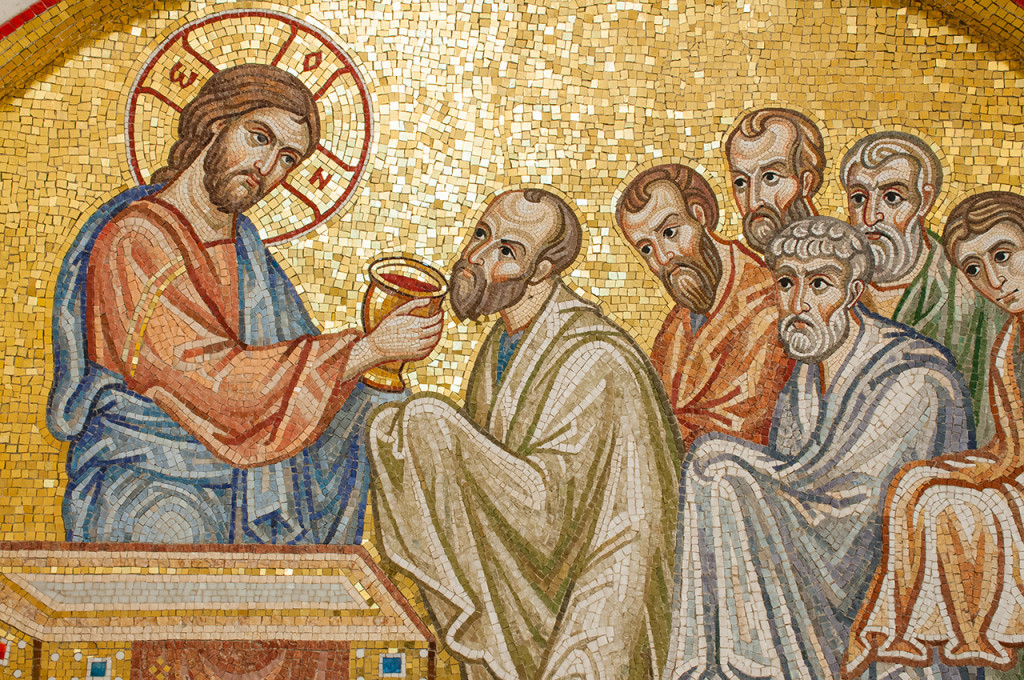耶穌基督之禮拜與神職運作
The Worship of Jesus Christ and His Priestly Function
「基督現在在哪裡?」這個問題的解答來自於祂的生天,祂「坐在聖父的右手邊」,是一位永恆的司祭(hiereus, archiereus),為了人類向聖父求情。從詩篇第110篇:「上主對我主起誓說:你坐在我右邊」當中我們可以得知,早期基督徒以「上主」(kyrios)來稱呼耶穌,並且視祂為上帝,祂與聖父一同接受眾人的祈禱和禮拜,祂是得救的新世代首領,是「眾多弟兄中的長子」(羅馬書8:29),祂使人類的祈禱和懇求得以呈現在聖父面前。這一點對於基督教靈修架構十分重要,它意味著基督教祈禱在本質上無異於「基督為了我們或是代替我們而向上帝做的祈禱」。它也意味著只有成為基督教的一份子,才能與上帝結合並且被帶到上帝面前,唯有在上帝唯一的兒子—「聖子」的體內的人,他們的祈禱才能被聖父聽見,才能獲得聖父的應允。因此,基督徒被教導要「以基督之名」來祈禱,並且這樣與祂結合為「一」,也就是上主基督的大身體。主禱文是耶穌親自教導門徒的祈禱,他們獲得特別的恩典稱呼上帝為阿爸(父親)並且被允許直呼上帝「我們天上的父」(馬太福音6:9)。教會中的聖餐禮儀與上述的特殊恩典具有相同的精神,這個「一」(基督)與「多」(教會)是相同的,是一個向上帝祈禱的卓越機會,能夠確保你們祈禱能夠被上帝所接收和應允,因為,這個祈禱的大團體的領導人就是上帝唯一的兒子—「聖子」,在祂體內上帝將會感到欣喜愉悅。
聖靈
在基督教的信仰中,聖靈的地位從一開始就非常重要。依據希伯來先知與帝王的傳統,「基督」這個專有名詞象徵著聖靈所選定的人,其中,耶穌是一個特例,耶穌就是彌賽亞,是末世最後一位先知與帝王,祂不僅充滿了上帝的聖靈,而且還在最後的時日,將這份禮物送給其他人(約珥書3:1-5)。耶穌的復活證明了祂就是末世的彌賽亞,也因為這個理由,在聖靈降臨節時,耶穌的復活使得聖靈遍佈在門徒的身上,也遍佈在所有人身上(使徒行傳2:17)。因此,就算基督再來之日延遲了,也不會使基督徒成為「孤兒」,這也意味著另一位慰藉者(聖靈)將會承擔起帶領基督徒的責任,並且堅固基督徒的信心,直到基督再來的那一天(約翰福音14:18)。從「基督復活」到「基督再來」的這段歲月中,聖靈的角色對於基督徒而言,就顯得十分重要。
在基督復活和升天之後,聖靈已被贈予並且開始作用,這意味著末世聖靈的禮物,已經出現在基督教團體中。教會的成員變得更加屬靈。在哥林多地區的基督徒的某一次辯論當中,討論了「靈修的等級」,保羅教導大眾:所有教會成員在某種程度上都是聖靈與聖靈之禮物的擁有者,真正的基督徒靈修絕對不會含有歧視的心,不會把某個聖靈的禮物視為最高,不會誤以為身體的一小部份可以鄙視他人或是獨立於他人而活,最高形式的靈修則是愛(哥林多前書13:13),因為聖靈是一種共融(communion)。因此,基督教靈修包含了複雜和多樣性的靈性神恩,這是無法在教會的共同體之外體驗到的。屬靈的人在許多事物上(包括舊約的法律)都是自由無礙的,唯有一件事可以使他們掛念 —- 就是他人的良心(哥林多前書 8:7-13;10:29;歌林多後書 5:11)。個人主義與基督教靈修是互不相容的。沒有人可以單獨擁有聖靈,只有教會這個共同體可以共同擁有聖靈。聖靈的風吹拂著我們,創造出教會的共同體而不是一個個單獨存在的好基督徒。這個概念延續了舊約的思想,成為新約當中的基督徒靈性基石。
教會
「聖靈的時代」(也就是基督徒期待基督二次再來的這段時期)在深層的意義上就是「教會的時代」,因為聖靈被視為一種「共融」,聖靈的禮物本來就是共同體,在基督內合一並且不斷向上帝祈禱的大團體,就根本上來說,我們可以將之稱為從死中復活的基督。在聖靈裡的生命被認定為屬於末日的共同體,那是由聖靈的禮物所組成的「彌賽亞共同體」。教會被視為末世的共同體,復活的主再來之時,教會全體將會聚在衪面前,上主也會徹底的證明自己(馬太福音25:30-31;使徒行傳9:5)。依據此概念我們可以得到這樣的結論,「教會是復活的基督的身體」與「教會是聖靈的共融」意義是完全相同的。聖靈的工作只有一個,就是在此時此地建立起基督的身體。聖靈不會脫離基督的身體而作用,我們不能把基督看作單獨的個體,祂在聖靈之內,是一個共同體,是同時包含著「多」的「一」。同樣地,離開了「一」(基督)的「多」也無法被理解。一即是多,多即是一的這種悖論深植於聖經的思想中,並且成為基督徒靈修的基礎。此種方式與其他非聖經形式的個人靈修不同,就本質而論,基督教靈修具有教會性。教會並不是一個提供指導、禮拜、恩典…等等資源而使人變得更加屬靈的媒介。教會是一個關係網絡,提供我們一個新的自我認同,此種認同有別於出生時社會所賦予的身份。因此,在早期基督教信仰中,要成為一個屬靈的人,就必須要有獲得「新生命」,在聖靈裡重生(約翰福音3:3)。
受洗與聖餐禮儀
早期教會將「新生」或「在聖靈裡出生」的概念與「受洗」相連。若是我們更深入探討「受洗」對於「基督教徒的存在方式」的意義,我們會發現,受洗是一個舊身份的死亡(這個身份是藉由生物過程的出生而得),受洗也是一個新生,也就是在新關係網絡中浮現的新身份,這個身份來自於教會,是我們與聖靈的共融。由生物過程獲得的身份,是與生俱來的,然而,靈性的新生卻出於我們的自由意願:(哥林多前書2:14 )Whereas biological identity is always bound by necessity, spiritual birth involves freedom: the spiritual person does not simply act differently from the natural person, the psychikos ( 1 Cor 2:14); the spiritual person is different in that personal identity is constituted in freedom from the necessity of nature. The new identity given “in the Spirit” was constituted through incorporation into the body of Christ, the church, through a new set of relationships. These relationships were identical to the relationship of Christ to the Father, and for this reason baptism amounted to sonship ( Rom 8:15), to acquiring the privilege of calling God “Father” as Christ himself in a unique and eternal way does. In the same way this identity involved social relationships, which were acquired in and through the community of the church and not through the biological family or the state. One of the fundamental consequences of baptism was that the “new man” would not have his father on earth but in “heaven” ( Matt 23:9) and that his “brethren” would be the members of the church. Similarly, he would have no citizenship on earth but in heaven ( Phil 3:11), since his “city” would be the “future” ( Heb 13:14) kingdom. Thus, he would be a stranger in this life. This was the existential meaning of baptism as “death” of “the old person” and birth of the “new” eschatological person. Its test was basically ecclesiological and not ethical or psychological as it is often thought. Spirituality had to do with acquiring new relationships and through them a new identity, since identities, whether biological, social, or “spiritual,” always emerge from relationships.
在這種背景之下,我們必須了解聖餐禮儀對基督教靈性的重要性。在第一世紀,聖餐禮儀被理解為將上帝四散的子民集中到「同一個地方」,不僅僅是慶祝而已,在此時此刻還要組成末世「彌賽亞共同體」。這就是最卓越的靈修,因為它是末世實相的顯現,是歷史中的預言。受洗的人為了置身其中而被引導至這個共同體裡,在這個共同體當中,我們可以像父子一般的與上帝說話,獲得如同基督所擁有的「上帝的兒子」的身份,也可以像同修一般向其他教會內的兄弟說話,並且分享他們永恆的生命。
The Eucharist offered positively what baptism meant negatively: the death of the old, biological identity was replaced by the birth of the new identity, which was given in the eucharistic community. Since the old biological identity is based on natural necessity, it leads to death; whereas the new identity given in the Eucharist–based on free and undying relationships, above all on the eternal filial relationship between the Father and the Son, which was “lent” to the Christian in baptism–gives eternal life. The Eucharist is life eternal, primarily because it offers this set of relationships, which involves an eternal identity.
Belonging to the community of the Eucharist is, therefore, tantamount to acquiring eternal life. Spirituality in this eucharistic context acquires an ontological and not simply a moral or a psychological context. It is not simply a matter of improving human nature and making it act and behave in a better way through moral achievement and virtue; it is not just a psychological experience of the fruits of the Spirit, such as peace, joy, patience, etc.; it is, above all, identical with overcoming death through the acquisition of a new identity based on new relationships which are identical with the Father-Son relationship of the Holy Trinity.
The Christian becomes by grace what Christ is by nature–to put the matter in later patristic dogmatic terminology. In strictly biblical terms this very thing is expressed by Paul in his reference to baptism as giving the “spirit” of sonship in which we cry “Abba! Father!” ( Rom 8:15). Spirituality as the possession of the Spirit involves, above all, sharing in the same sonship of Jesus Christ, a relationship with God that gives an undying, eternal identity. Membership in the church as the body of those who through baptism and the Eucharist have acquired such an identity was the source of true spirituality. Spirituality is an ecclesial and not an individual experience.
The church, as the “image” or the “sign” of the eschatological community, offered through the Eucharist the foretaste of eternal life by providing believers with the set of relationships that would give them an undying, eternal identity as well as the experience of a life in which all natural and social divisions involving disintegration and death would be overcome in the unity of the body of Christ. This last point became extremely significant for the life of the church in the New Testament period. The way the eucharistic community was composed portrayed the “way of being” that will characterize the kingdom. Thus, the following characteristics eventually became permanent features of the eucharistic community in the early church. First, all the members of the church in a certain place should gather together in the same place (epi to auto) ( 1 Cor 11:20), exactly as all the dispersed people of God would be brought together from the ends of the earth in the kingdom (Didache 9 and 10). This meant in practice that there could be only one eucharistic community in each place (originally in a city, since Christianity started as an urban religion). Second, there is “neither Jew nor Greek, there is neither slave nor free, there is neither male nor female” ( Gal 3:28) in the composition of the eucharistic community. All divisions, both natural (age, race, sex, etc.) and social (profession, social or economic status, etc.) are transcended in the Eucharist. This meant that the eucharistic community was a catholic community, and the members of this community were expected to show a catholic ethos in their spiritual life. Exclusiveness, based on natural or social discriminations of any kind ought to be foreign to Christian spirituality, because such exclusiveness contradicted the kingdom of God, of which the eucharistic community was understood to be a figure and an anticipation in history. Third, there should be ministries in the eucharistic community that would serve as types or images of the kingdom. A basic distinction between those who lead the eucharistic community by offering the Eucharist and those who confirm or seal this action with their “Amen” is already present in Paul’s first letter to the Corinthians (14:16). This distinction became the basis of the church’s order. The clergy-laity distinction (see 1 Clement ) marks the early church in a decisive way. Christian spirituality was conditioned by this order so strongly that it became necessary to introduce almost legalistic safeguards to spirituality so as to keep it ecclesial in its nature. The patristic era, as we shall see, is marked by this tendency, but the roots of this attitude are to be found in the New Testament view that Christian existence is in its nature eschatological and that it is in the way the eucharistic community is formed that we have the measure of our conformity to this eschatological model of life and spirituality.


